How to turn yourself into a fossil

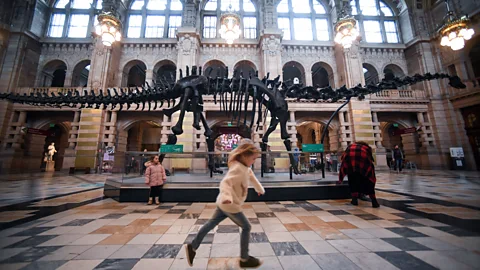 Getty Images
Getty ImagesDiscovering the preserved remains of a once-living creature entombed within stone for millions of years is as fascinating as it is special. But Richard Fisher wonders if there is a way of increasing our own chances of being fossilised – and unearthed in ages to come.
Sitting on my desk as I write this is a trilobite – a woodlouse-like creature with bulbous eyes, spindly legs and a head like a horseshoe crab. I'm glad that it died millions of years ago, because if it was alive now, it would probably freak me out. I suspect it was a creature that scuttled.
I've been fascinated by fossils like this since I was a child, collecting several ammonites, a flattened fish, a dinosaur vertebrae and various other organisms of the deep past. What I love about them is how they can transport the mind away from the present: each one is a window to a time and place that no longer exists. Looking at these ancient creatures – trying to imagine how they lived, moved and behaved – I have often wondered what palaeontologists in the far future might make of the fossils of the 21st Century: the blue whales, the elephants, the grizzly bears… the human beings.
This daydream has often led me to wonder: could I myself end up preserved and mineralised, like my pet trilobite?
Recently, I got the opportunity to seek some answers. One day, my editor asked me what it might take to fossilise a person: a journalist, for instance.
The Immortality Project
This article is part of The Immortality Project. To celebrate BBC Future's 10th birthday this year – and the wider BBC's 100th – we are exploring what it takes to have a legacy that lasts not just decades but millennia. From long-lived sandwiches to venerable knowledge, art and even religions, we'd like to know how some things survive for thousands or even millions of years, and use this insight to look at whether it is possible to leave a mark on the world that extends into the deep future. There will be articles, videos and experiments.
So, if I set out to be fossilised, how might I increase the odds of success? Where in the world should I go? Which of my body parts would last the longest: my bones, skin and muscles, or my toenails? And could there be ways of accelerating, or artificially tweaking the process?
Starting out, I had a rough idea of how fossilisation works, and handily BBC Future had published a seven-step guide that answered some of my basic questions. However, I soon realised I needed specific professional advice from a palaeontologist. I called up Jakob Vinther, a professor in macroevolution at the University of Bristol, who studies highly-detailed, exceptional specimens like feathered dinosaurs, and the pigments they left behind.
It turned out Vinther had already thought a lot about how to fossilise himself – he's contemplating writing a book about it – so was the perfect person to ask. To him, it is a serious question worth exploring for more than just morbid curiosity. Thinking more deeply about how our own bodies might fossilise could help enhance people's understanding of what is lost during the process. "We are flesh and blood, and we have things that can fossilise and things that don't," he explains.
"If we could translate ourselves and what we would look like as a fossil, then maybe that could be a way for people to better reverse-engineer another organism into a flesh-and-blood living being that once existed." After all, no fossil offers a complete picture. "Many dinosaur reconstructions look very freaky because they're 'shrink-wrapped'. People just have the skeleton and then they just put a bit of flesh on the outside," he says. This involves big guesses about appearance and behaviour.
The first thing Vinther told me, however, was the bad news. It's very unlikely that either one of us will be lucky enough to become a fossil that future generations discover."It takes extraordinary measures. If we get buried whole in typical soil our bones may survive for, say, 100 years. If we want to preserve skeletons for much further than that, you oftentimes need better conditions," he says.
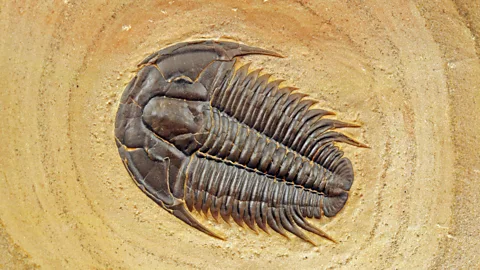 Getty Images
Getty ImagesIndeed, the majority of species that have ever lived are not preserved in the fossil record – that's species, not organisms. It means there were once whole populations of animals on Earth that existed, but left no trace. "Fossils offer such an extraordinary glimpse, and such an incomplete glimpse into past diversity," he says.
Finally, even if Vinther or I were lucky enough to fossilised, it's unlikely that either of us would ever be found by a person, and not just because it requires intelligent beings with rock hammers to take an interest. Trillions of fossils remain locked deep below the ground, and will only be discovered if the rocks that contain them are uplifted and exposed – and, crucially, not broken up by the ocean, weather or natural erosion before discovery.
That said, it's not totally impossible. So, how could it happen?
Location, location, location
First up, don’t worry – I am not planning anything morbid. I'm just scoping out my potential options, so I know how to maximise my chances of eventually being fossilised in my entirety.
You may also like:
One option for achieving this is the "subfossil" route. There are a few places on Earth that promise longer-term preservation – at least, long-term enough to be of interest to a future archaeologist.
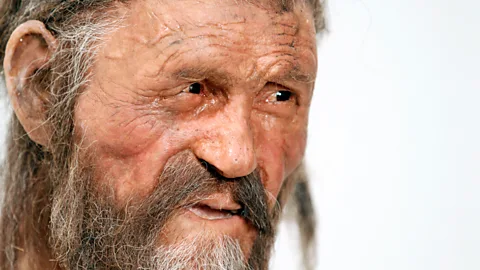 Andrea Solero/Getty Images
Andrea Solero/Getty ImagesFor starters, I could try to get frozen somewhere cold and stable. After all, prehistoric people have been found inside Alpine glaciers, such as Oetzi, a man who lived around 5,000 years ago. Or I could go lie down in a desert cave, so long as I sealed myself off from scavengers. Ancient remains up to 10,000 years old have been found preserved in dry caves in Peru. And then there are peat bogs.
Occasionally a "bog body" is found in peat from thousands of years ago – sometimes the unfortunate victim of a ritual sacrifice, such as the Lindow man, discovered in north-west England in the 1980s. He lived around the same time as the Romans, and had his soft tissue preserved thanks to the sphagnum moss and the peat's unique chemical environment. For this, I wouldn't even have to travel far: among the nearest peat bogs to me are the mires of the New Forest, around 80 miles (125km) from London.
It would seem, then, that I'm spoilt for choice – would I want to be iced, mummified or peat-pickled?
There are, however, downsides to pursuing this subfossil route, as Vinther explained to me. While these methods might get me into a future museum or studied in a laboratory, they are nowhere near as long-term as a proper mineralised fossil, embedded in rock, he says. No ice lasts millions of years: if it did, we'd find frozen dinosaurs and be able to extract their DNA. Meanwhile, dry cave remains are more like prunes than fossils, because they have never got wet enough to mineralise. And while peat preservation would work for a few thousand years, the bog itself is likely to erode away eventually, unless it somehow gets buried beneath overlying sediment.
So I quiz Vinther about some of other possibilities that come to mind. How about the famous La Brea tar pits of Los Angeles? After all, the pits contain the remains of various prehistoric megafauna that once fell in. Maybe, he says, but I should know that not much of my soft tissue would be preserved. And in the tar pits' energetic environment, my bones would probably get jumbled up and separated.
 Getty Images
Getty ImagesWhat about a landfill dump? Vinther shakes his head. "Landfill would not be good because it's an elevated place. Generally to become a fossil you need to get below the groundwater table. That's the rule of thumb. Everything above will ultimately erode."
If I'm serious about getting fossilised for millions of years, Vinther explains, I need to consider different locations: places where I'll get wet, get buried and avoid getting eaten. Also key, he says, is that oxygen quickly disappears. "With the lack of oxygen there are no macroscopic organisms that can easily navigate around and come for you," he says. "There are anaerobic bacteria that can still digest you, but they do it less efficiently. And these bacteria produce waste products that can potentially even enhance preservation of certain tissues inside you."
What kinds of places might offer such conditions? "Truly ancient fossils are preserved in windows where humans don't necessarily typically end up unless they're really unlucky," he says. "Typically the way fossils are made is in rivers, in lakes, in the sea, and hence you only end up there by accident: by drowning."
Well, that would seem to be good news, apart from the drowning part. After all, there are plenty of conveniently-located rivers near me, such as the Thames, and the south coast of England is a short distance away. Unfortunately, it's not as simple as that, says Vinther. The vast majority of things that fall into a river won't fossilise because hardly anything stays intact for long, due to currents and scavengers. The same goes for the ocean close to the coastline. It's possible that a low-circulation lake could work – many of the well-preserved feathered dinosaurs found in China were buried this way – but you need specific conditions. Many of these exceptional Chinese fossils were subsumed in ash from nearby volcanic eruptions, which is quite an unusual scenario to hope for if you live in the UK.
"Typically, you need to get washed out [to sea] and buried deeper," Vinther explains. One of the more reliable locations, he says, would be the ocean floor far enough from land to avoid getting churned up by wave action and animals, but not so deep that there's not enough sediment to bury you quickly. In fact, there could already be people beginning to be fossilised this way. "Humans have been sailing a lot, and there have been lots of shipwrecks."
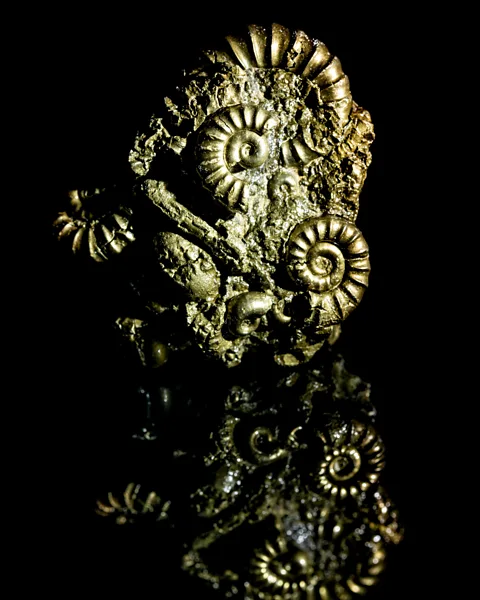 Getty Images
Getty ImagesIn such marine settings, there's also the small possibility of becoming a "golden" fossil. If I got buried in iron-rich mud in seawater that contained enough sulphate – along with sulphate-reducing bacteria – then my body could be converted into pyrite. "Your soft tissues can more or less become replaced by that, in three dimensions," Vinther says. I must confess, the prospect of becoming a glittering specimen sounds appealing – even though it would be "fool's gold" rather than the real stuff.
Which parts?
A second vein of questions concern body parts: which bits of me would be most likely to endure? Based on prehistoric hominin fossils, it's perhaps obvious that my teeth and bones would be the best candidates. However, there are soft bits that might fossilise too, says Vinther. What works against me in particular, however, is the fact that I am white-skinned with light brown hair. This means my skin and hair contains less melanin, he explains, a pigment whose shadow can be preserved for millions of years. Unlike the keratin in my skin, nails and soft tissue, melanin is less likely to break down. This is why darker feathers from dinosaurs are visible to palaeontologists, but not their light feathers. It's also why people with darker skin and hair than I have are much more likely to be regarded as exquisite fossils by future palaeontologists.
However, Vinther says it's possible that my melanin-containing organs could show up, such as the liver. He also had news for me about which part of my pale outer body was most likely to be visible in future rocks… my genitals. It's because the skin in this part of the body is slightly darker than regions exposed to the Sun every day, he says.
If that thought wasn't humiliating enough, it also seems my lack of big muscles is a problem. Under the right conditions, muscle tissue can get preserved by releasing phosphate. "If you have calcium present and a low pH, then you can get precipitation of calcium phosphate, and if this happens early enough, then this will replicate the individual muscle fibres," says Vinther. I'm far too wiry to hope for that.
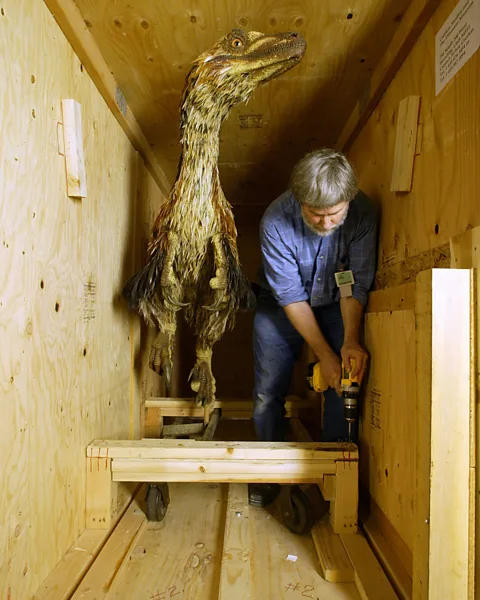 Getty Images
Getty ImagesHow about the "disposable" parts? Toenails, earwax, faeces? Most of the stuff that the body produces degrades pretty quickly, even if buried. Fossil poo, for example, does exist – we have the famous palaeontologist Mary Anning to thank for finding some of the earliest examples in the 1800s – but such coprolites are very rare. Of my own disposable bodily productions, it's likely that, at most, only the calcium phosphate in my toenails might stick around to fossilise. "If you go to a black light party in Ibiza, you will see that your nails, they kind of like look sort of ghostly fluorescence, and that's because of the calcium phosphate in our nails. That could fossilise and leave a faint imprint of where the nail was," says Vinther. However, most the nail – made of keratin – would have long faded away.
So, probably the best I could realistically hope for is to eventually fossilise my skeleton and teeth, perhaps my liver, and maybe if I'm truly lucky, ghostly imprints of my toenails and private parts. What a legacy for future generations that would be.
Faster fossils
Given these low odds, I wondered: could there be a way of cheating? For example, might there be a way of artificially inducing fossilisation to avoid some of the pesky barriers? To my surprise, I discovered that there might be – or at least, there's a way to accelerate part of the early process. It's a relatively new technique developed by Evan Saitta of the University of Chicago – a colleague of Vinther's – called "sediment-encased maturation".
When organic matter is buried, and before it mineralises, it undergoes a process called thermal maturation. This normally takes a long time, but Saitta suspected that it might be possible to speed it up in the laboratory. It's a bit like pressure cooking. "If you cook a turkey in the oven, it takes three hours, but if you're in a pressure cooker, it takes 30 minutes," he explains.
Saitta was inspired to explore the process after some experiments with a bird carcass. He and colleagues had encased a finch within some sediment and water to create a sort of pseudo-rock, curious about whether they could simulate early fossilisation. It didn't work especially well, but this led him to wonder: what if he had heated and pressurised it too? One day, he got talking to an engineer he'd met a conference, Tom Kaye of the Foundation for Scientific Advancement in Arizona, who reckoned he could build something at his home, where he has a metal workshop in his garage.
A few months later, Saitta and Kaye were building their contraption, ready to experiment with a collection of lizards, insects, tree resin, feathers and vegetation. Their device featured repurposed air compressors ("I think they came from Tom's paintball days," says Saitta), and a pill press that is usually for making herbal supplements. "It was such a monstrosity," he recalls. But it worked.
Each night in Arizona, they'd start a batch and then eagerly crack open the results in the morning. "We'd argue over who gets to split them open like Christmas presents," he recalls. "We could split open this little tablet and get a 'fossil' in fine-grained sediment: dark staining in feathers, browned bones, dark halos of the soft tissues around the bones… what you see in Chinese feathered dinosaurs."
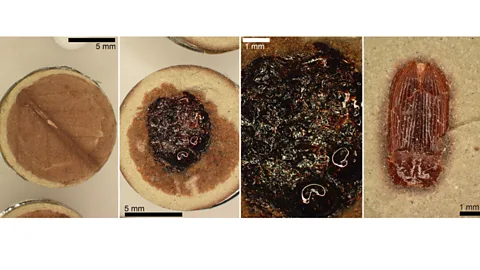 Evan Saitta et al
Evan Saitta et al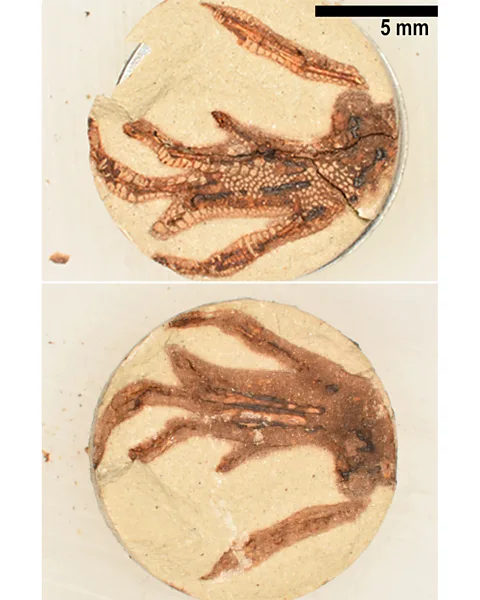 Evan Saitta et al
Evan Saitta et alTo be clear, maturation is just the first step of fossilisation. The mineralisation and crystallisation that leads to long-term preservation is a whole different process that happens later. And their results are also pretty small, producing specimens only a couple of centimetres across. But I was surprised by how much they look like real fossils.
Could Saitta and Kaye make a human-sized version of their fossiliser? They would like to build something bigger, they just need the budget. But the answer is yes, in principle. Fossilising me might just land them in prison, that's all.
Amber up
Given that I don't want to get any palaeontologists into trouble, there's one other shortcut for the would-be fossil-maker: the amber method.
As Caitlin Syme, a taphonomist at the University of Queensland, Australia told BBC Future in 2018: "If you can find a large enough amount of tree sap and get covered in amber, that’s going to be the best way to preserve your soft tissues as well as your bones. But it’s obviously pretty difficult for such a large animal."
With that in mind, I asked Vinther about how it might be simulated. "Amber is essentially a plastic, a polymerised organic substance," he explains. Therefore, if I jumped into a vat of polyurethane, and someone buried me on the floor of the ocean, that could work. (It would also, he points out, be morbidly emblematic of the plastic-rich early Anthropocene.)
Inspired by this but reluctant to go swimming in polyurethane, I decided to conduct an at-home experiment. One afternoon, my 9-year-old daughter and I took part in a wholesome craft project involving epoxy resin, which is among the next best things to amber. You don’t need to heat it up to melt it, and it dries into a solid plastic block. Thankfully, BBC budgets don't stretch far enough to encase my entire body, so instead, I decided to preserve my fingernails and toenails – as well as a few fragments of belly-button fluff for good measure.
With great ceremony, my daughter and I placed my nails and fluff into the liquid epoxy in a silicone cupcake holder, along with a small pebble on which we wrote "Hello from 2022".
"Why are we doing this, Dad?" my daughter asked. Good question, I replied.
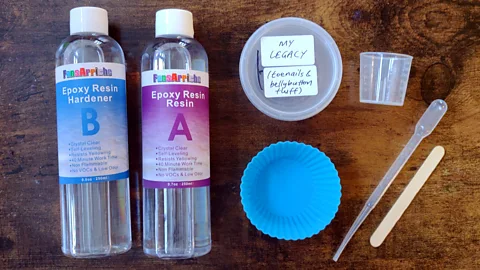 Richard Fisher
Richard Fisher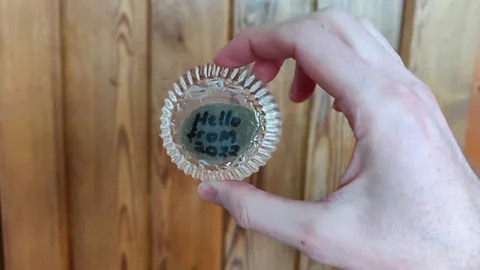 Richard Fisher
Richard FisherWhen it was ready, 24 hours later, I considered dropping my makeshift resin fossil into the sea, knowing this had the best odds of deep burial. But the ocean has far too much plastic in it already, so I decided against it. Instead, I simply buried it in my garden, with the Jurassic Park theme-tune playing in my head as I dug up the soil.
Will my plastic-encased toenails survive the ages? Almost certainly not, but it was the simplest method I could think of to create a "fossil" without dying, chopping off an arm or removing a tooth. I also like to imagine that one day, someone will find it and wonder who had been motivated to leave behind this strange object.
Perhaps after I've lived a long and healthy life, I'll be lucky enough to become a whole true fossil myself – just like the trilobite sitting on my desk. I now know just how unlikely it is, but what more permanent legacy could there be?
*Richard Fisher is a senior journalist for BBC Future and tweets @rifish
--
If you liked this story, sign up for the weekly bbc.com features newsletter, called "The Essential List" – a handpicked selection of stories from BBC Future, Culture, Worklife, Travel and Reel delivered to your inbox every Friday.
